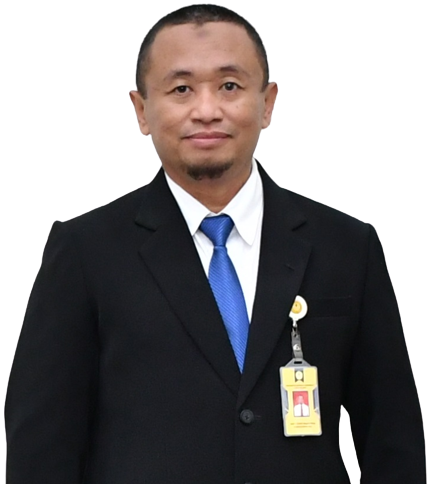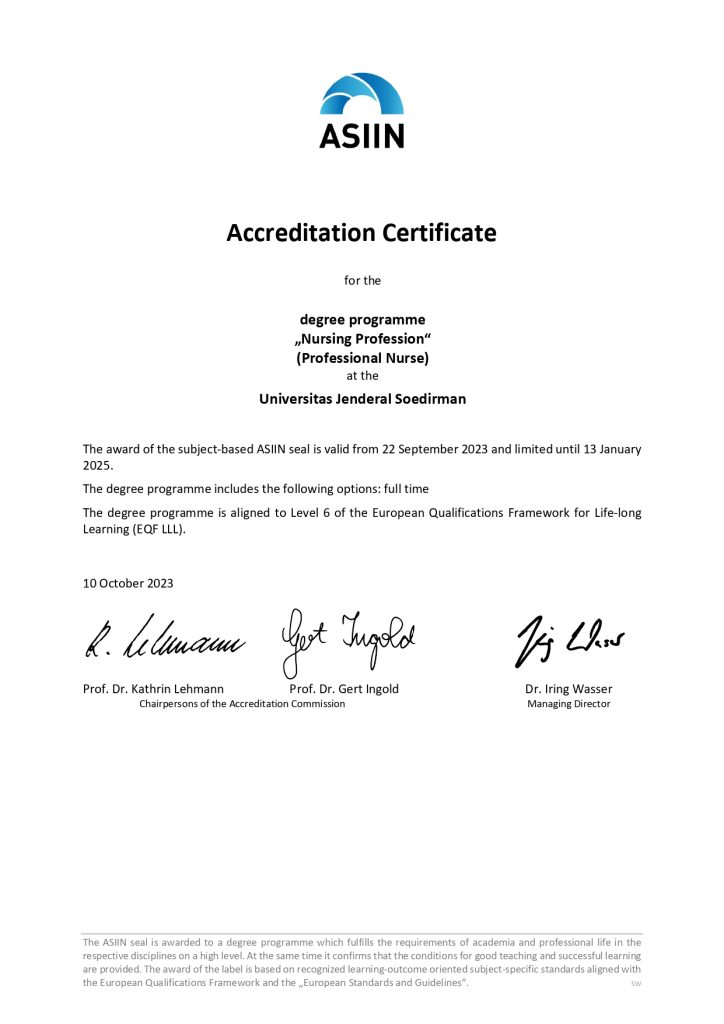
- Email fikes@unsoed.ac.id
- Telp. +62 281 6572772

PENDAFTARAN
 |
| Dr. Arif Setyo Upoyo, Ns., M.Kep Ketua Program Studi |
Program Pendidikan Profesi Ners merupakan satu kesatuan utuh dengan Program Pendidikan Akademik (Sarjana Keperawatan), dimana tahap Program Pendidikan Profesi Ners dilaksanakan setelah menyelesaikan sarjana keperawatan. Pendidikan profesi keperawatan bertujuan untuk menyiapkan peserta didik untuk mampu melaksanakan fungsi dan peran sebagai ners. Hal ini sesuai dengan keputusan menteri pendidikan nasional Republik Indonesia No. 232/U/2000 pasal 2 ayat 2 bahwa program pendidikan profesional bertujuan untuk menyiapkan peserta didik menjadi anggota masyarakat yang memiliki kemampuan profesional dalam menerapkan, mengembangkan, dan menyebarluaskan teknologi dan/atau kesenian serta mengupayakan penggunaannya untuk meningkatkan taraf kehidupan masyarakat dan memperkaya kebudayaan nasional. Program pendidikan profesi ners dilaksanakan setelah menyelesaikan program sarjana keperawatan dengan beban studi minimal 36 sks (SK Mendiknas, No. 232/U/2000 pasal 5 ayat 2).
Pendidikan Profesi Ners Fakultas ilmu-ilmu Kesehatan Universitas Jenderal Soedirman mengacu pada KKNI (Kerangka Kualifikasi Nasional Indonesia). Tingkat kedalaman dan keluasan kurikulum program profesi berada pada level 7 dari 9 level KKNI. Permendikbud Nomor 3/2020 tentang Standar Nasional Pendidikan Tinggi, menekankan bahwa penyusunan kurikulum pendidikan tinggi berorientasi pada capaian pembelajaran (learning outcome). Dimana dalam proses pembelajaran berorientasi pada capaian (Outcome Based Learning and Teaching/OBLT) begitupula evaluasi dan penilaian berorientasi pada capaian (Outcome Based Assessment and Evaluation/OBAE).
Pendidikan Profesi Ners Fakultas Ilmu-ilmu Kesehatan Universitas Jenderal Soedirman diselenggarakan dengan beban kredit semester berjumlah 36 SKS yang ditempuh dalam 2 semester. Pembelajaran dilaksanakan di tatatan klinik dan komunitas.
Pendidikan Profesi Ners Fakultas Ilmu-ilmu Kesehatan Universitas Jenderal Soedirman telah terakreditasi A (Sangat Baik) berdasar Surat Keputusan Lembaga Akreditasi Mandiri Pendidikan Tinggi Kesehatan Indonesia nomor 0146/LAM-PTKes/Akr/Pro/IV/2020.

Unduh Sertifikat Internasional ASSIN disini
Pedoman Umum Profesi Ners Tahun Ajaran Akademik 2023-2024, bisa unduh disini
| PROFESSION SEMESTER I | ||||||
| No | Course Code | Course (MK) | Credit weight | |||
| Theory | Internship | Practice | Sum | |||
| 1 | NSA211801 | Fundamental of Nursing Profession Practice | 2 | 2 | ||
| 2 | NSA211802 | Medical Surgical Nursing Profession Practice | 7 | 7 | ||
| 3 | NSA211803 | Pediatric Nursing Profession Practice | 4 | 4 | ||
| 4 | NSA211804 | Maternity Nursing Profession Practice | 4 | 4 | ||
| 5 | NSA211805 | Emergency and Critical Nursing Profession Practice | 4 | 4 | ||
| Total Study Load in the First Semester | 21 | 21 | ||||
| PROFESSION SEMESTER II | ||||||
| No | Course Code | Course (MK) | Credit weight | |||
| Theory | Internship | Practice | Sum | |||
| 1 | NSA211906 | Mental Nursing Profession Practice | 3 | 3 | ||
| 2 | NSA211907 | Nursing Management Profession Practice | 3 | 3 | ||
| 3 | NSA211908 | Gerontology Nursing Profession Practice | 2 | 2 | ||
| 4 | NSA211909 | Family Nursing Profession Practice | 2 | 2 | ||
| 5 | NSA211910 | Community Nursing Profession Practice | 3 | 3 | ||
| 6 | NSA211911 | Final Scientific Work | 2 | 2 | ||
| Total Study Load in Semester II | 15 | |||||
Full document Download Here (for further information contact email keperawatan@unsoed.ac.id)
PERSYARATAN PENDAFTARAN PROGRAM STUDI PROFESI NERS TAHUN 2024
Untuk persyaratan khusus peserta dari LUAR UNSOED berasal dari instansi yang Terakreditasi Minimal B atau Baik Sekali dengan IPK >3,25 dan telah dinyatakan lulus pada status PDDIKTI S1
Pendaftaran melalui link berikut : profesi.bapendik.unsoed.ac.id
ALUR PENDAFTARAN
Berkas yg dikirim ke Bapendik Jurusan Keperawatan Fikes Unsoed adalah sebagai berikut:
PENGUMUMAN KELULUSAN SELEKSI NERS
Syarat Kelulusan :
Calon Mahasiswa Profesi Ners Dinyatakan Lulus Seleksi Jika Nilai Akhir Memenuhi Nilai Ambang Batas Lulus ≥60.
Fakultas Ilmu-ilmu Kesehatan
We firmly believe that the internet should be available and accessible to anyone, and are committed to providing a website that is accessible to the widest possible audience, regardless of circumstance and ability.
To fulfill this, we aim to adhere as strictly as possible to the World Wide Web Consortium’s (W3C) Web Content Accessibility Guidelines 2.1 (WCAG 2.1) at the AA level. These guidelines explain how to make web content accessible to people with a wide array of disabilities. Complying with those guidelines helps us ensure that the website is accessible to all people: blind people, people with motor impairments, visual impairment, cognitive disabilities, and more.
This website utilizes various technologies that are meant to make it as accessible as possible at all times. We utilize an accessibility interface that allows persons with specific disabilities to adjust the website’s UI (user interface) and design it to their personal needs.
Additionally, the website utilizes an AI-based application that runs in the background and optimizes its accessibility level constantly. This application remediates the website’s HTML, adapts Its functionality and behavior for screen-readers used by the blind users, and for keyboard functions used by individuals with motor impairments.
If you’ve found a malfunction or have ideas for improvement, we’ll be happy to hear from you. You can reach out to the website’s operators by using the following email
Our website implements the ARIA attributes (Accessible Rich Internet Applications) technique, alongside various different behavioral changes, to ensure blind users visiting with screen-readers are able to read, comprehend, and enjoy the website’s functions. As soon as a user with a screen-reader enters your site, they immediately receive a prompt to enter the Screen-Reader Profile so they can browse and operate your site effectively. Here’s how our website covers some of the most important screen-reader requirements, alongside console screenshots of code examples:
Screen-reader optimization: we run a background process that learns the website’s components from top to bottom, to ensure ongoing compliance even when updating the website. In this process, we provide screen-readers with meaningful data using the ARIA set of attributes. For example, we provide accurate form labels; descriptions for actionable icons (social media icons, search icons, cart icons, etc.); validation guidance for form inputs; element roles such as buttons, menus, modal dialogues (popups), and others. Additionally, the background process scans all of the website’s images and provides an accurate and meaningful image-object-recognition-based description as an ALT (alternate text) tag for images that are not described. It will also extract texts that are embedded within the image, using an OCR (optical character recognition) technology. To turn on screen-reader adjustments at any time, users need only to press the Alt+1 keyboard combination. Screen-reader users also get automatic announcements to turn the Screen-reader mode on as soon as they enter the website.
These adjustments are compatible with all popular screen readers, including JAWS and NVDA.
Keyboard navigation optimization: The background process also adjusts the website’s HTML, and adds various behaviors using JavaScript code to make the website operable by the keyboard. This includes the ability to navigate the website using the Tab and Shift+Tab keys, operate dropdowns with the arrow keys, close them with Esc, trigger buttons and links using the Enter key, navigate between radio and checkbox elements using the arrow keys, and fill them in with the Spacebar or Enter key.Additionally, keyboard users will find quick-navigation and content-skip menus, available at any time by clicking Alt+1, or as the first elements of the site while navigating with the keyboard. The background process also handles triggered popups by moving the keyboard focus towards them as soon as they appear, and not allow the focus drift outside of it.
Users can also use shortcuts such as “M” (menus), “H” (headings), “F” (forms), “B” (buttons), and “G” (graphics) to jump to specific elements.
We aim to support the widest array of browsers and assistive technologies as possible, so our users can choose the best fitting tools for them, with as few limitations as possible. Therefore, we have worked very hard to be able to support all major systems that comprise over 95% of the user market share including Google Chrome, Mozilla Firefox, Apple Safari, Opera and Microsoft Edge, JAWS and NVDA (screen readers), both for Windows and for MAC users.
Despite our very best efforts to allow anybody to adjust the website to their needs, there may still be pages or sections that are not fully accessible, are in the process of becoming accessible, or are lacking an adequate technological solution to make them accessible. Still, we are continually improving our accessibility, adding, updating and improving its options and features, and developing and adopting new technologies. All this is meant to reach the optimal level of accessibility, following technological advancements. For any assistance, please reach out to